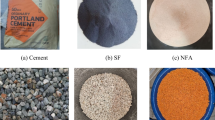Abstract
When molten silicon manganese slag contacts with water, it is cooled down rapidly with much water vapor and to be a rock masses like as volcano rock. This porous rock may be used as a lightweight aggregate. In this study, we have tried to evaluate engineering properties of this material to use for construction fields. In the view point of engineering properties, such as low density and low water absorption, regular shape the aggregate cooled by air–water is comparatively superior to other cooling condition. Depending on the ratio of air to water, the size of the pore in aggregate is found to change, and the higher the ratio of water, the higher the average pore size. The effect of pore size and pore volume has a direct effect on mortar, and the dry shrinkage is low in mortar using air–water mixed rapidly cooled aggregates. In mortar engineering properties, the mortar replacing air–water mixed rapid cooled aggregate shows comparatively proper properties, such as unit weight of 1682 kg/3 and compressive strength of 22.9 MPa, which means that this lightweight aggregate has the possibility as a structural lightweight aggregate.






















Similar content being viewed by others
References
Kim YJ, Choi YW (2010) The quality properties of self consolidating concrete using lightweight aggregate. Korean Soc Civil Eng 30(6A):573–580
Rossignolo JA, Agnesini MVC, Morais JA (2003) Properties of high-performance LWAC for precast structures with Brazilian lightweight aggregate. Cem Concr Composit 25(1):77–82
Yasar E, Atis CD, Kilic A, Gulsen H (2003) Strength properties of lightweight concrete made with basaltic pumice and fly-ash. Mater Lett 57(15):2267–2270
Holm TA (2001) Lightweight concrete and aggregates. ASTM Spec Tech Publ 169C(48):522–532
Korea Institute of Civil Engineering and Building Technology (2014) Study on activation measures of recycled aggregate, 11–1613000-000638-01. Ministry of Land, Infrastructure and Transport, pp 3–34
Korea Construction Economy and Industry Association (2014) Study on master plan establishing of aggregate demand and supply, 1–1613000-000269-13. Ministry of Land, Infrastructure and Transport, pp 71–157
Kim KD, Kang SG (2007) Manufacturing artificial lightweight aggregates using coal bottom ash and clay. J Korean Cryst Growth Cryst Technol 17(6):277–282
Jo BW, Kwon OH, Park SK (2004) Development of fly-ash artificial lightweight aggregate by non-sintering and an experimental study on its application of concrete. J Korean Soc Civil Eng 24(2A):293–299
Sun JS, Kim JM, Sung JH (2016) Evaluation on the applicability of dry processed bottom ash as lightweight aggregate for construction fields. J Mater Cycles Waste Manag 18(4):752–762
Juenger MCG, Winnefeld F, Provis JL, Ideker JH (2011) Advances in alternative cementitious binders. Cem Concr Res 41:1232–1243
Oeters F (1989) Metallurigie der Stahlherstellung. Springer-Verlag, Berlin Heidelberg, p 1989
Kourounis S, Tsivilis S (2007) Properties and hydration of blended cements with steelmaking slag. Cem Concr Res 37:815–822
Frias M, Sanchez de Rojas MI (2004) Chemical assessment of the electric arc furnace slag as construction material: Expansive compounds. Cem Conc Res 34:1881–1888
Altun I, Uilmaz I (2002) Study on steel furnace slags with high MgO as additive in Portland cement. Cem Concr Res 32:1247–1249
Frias M, Sanchez de Rojas MI, Santamaria J, Rodriguez C (2006) Recycling of silico-manganese slag as pozzolanic material in Portland cements: Basic and engineering properties. Cem Concr Res 36:487–491
Choi S, Kim J, Oh S, Han D (2017) Hydro-thermal reaction according to the CaO/SiO2 mole-ratio in silico-manganese slag. Mater Cycles Waste Manag 19(1):374–381
Patil AV, Pande AM (2011) Behaviour of silico manganese slag manufactured aggregate as material for road and rail track construction. Adv Mater Res 255:3258–3262
Choi S, Kim JM, Han D, Kim JH (2016) Hydration properties of ladle furnace slag powder rapidly cooled by air. Constr Build Mater 113:682–690
Yun KK, Jeong WK, Kwon HC, Jun IK, Lee BH (2004) Analysis of air voids system using image analysis technique in hardened concrete. J Korea Concr Inst 16(6):741–750
Korean Agency for Technology and Standard (KATS) (2016) Concrete Aggregate (KS F 2527). Korean Standard Association (KSA), Korea, Seoul
Lee CS, Park JH, Jung BJ, Choi YJ (2009) Relation between shrinkage and humidity on lightweight concrete and normal concrete by water-cement ratio. J Korean Soc Civil Eng 29(4A):385–393
Federation Internationale de la Precontrainte (1983) FIP Manual of Lightweight Aggregate Concrete, 2nd edn. Surrey Univ. Press, London
Khandarker M, Hossain A (2004) Properties of volcanic pumice based cement and lightweight concrete. Cem Concr Res 34(2):283–291
Acknowledgement
This work was supported by the Korea Institute of Energy Technology Evaluation and Planning (KETEP) and the Ministry of Trade, Industry & Energy (MOTIE) of the Republic of Korea (No. 20182010202100).
Author information
Authors and Affiliations
Corresponding author
Additional information
Publisher's Note
Springer Nature remains neutral with regard to jurisdictional claims in published maps and institutional affiliations.
Rights and permissions
About this article
Cite this article
Choi, HB., Kim, J.M. Properties of silicon manganese slag as an aggregate for concrete depending on cooling conditions. J Mater Cycles Waste Manag 22, 1067–1080 (2020). https://doi.org/10.1007/s10163-020-01003-8
Received:
Accepted:
Published:
Issue Date:
DOI: https://doi.org/10.1007/s10163-020-01003-8




